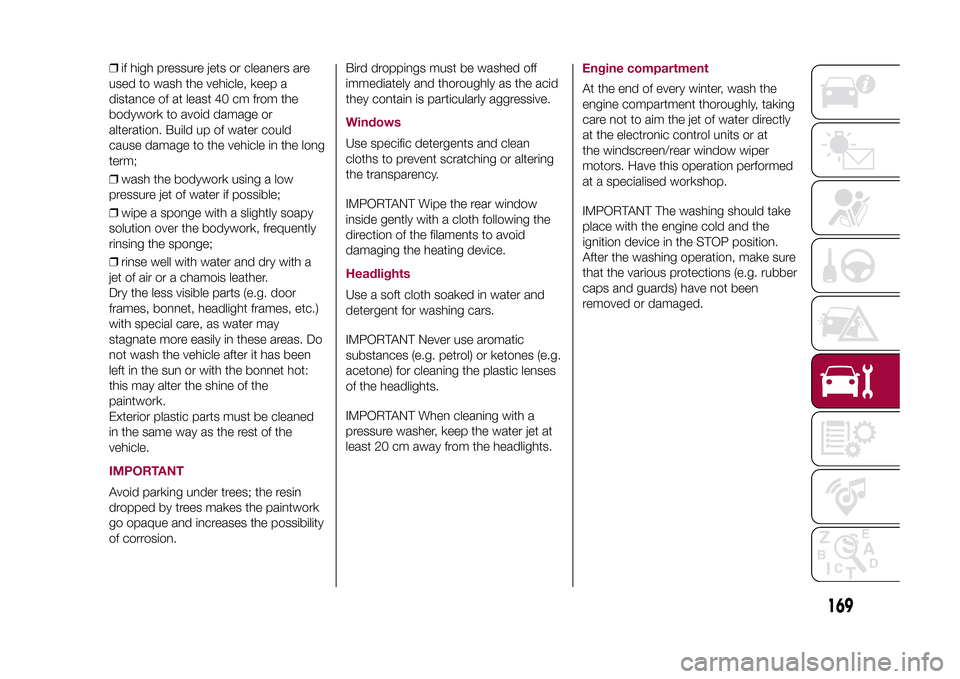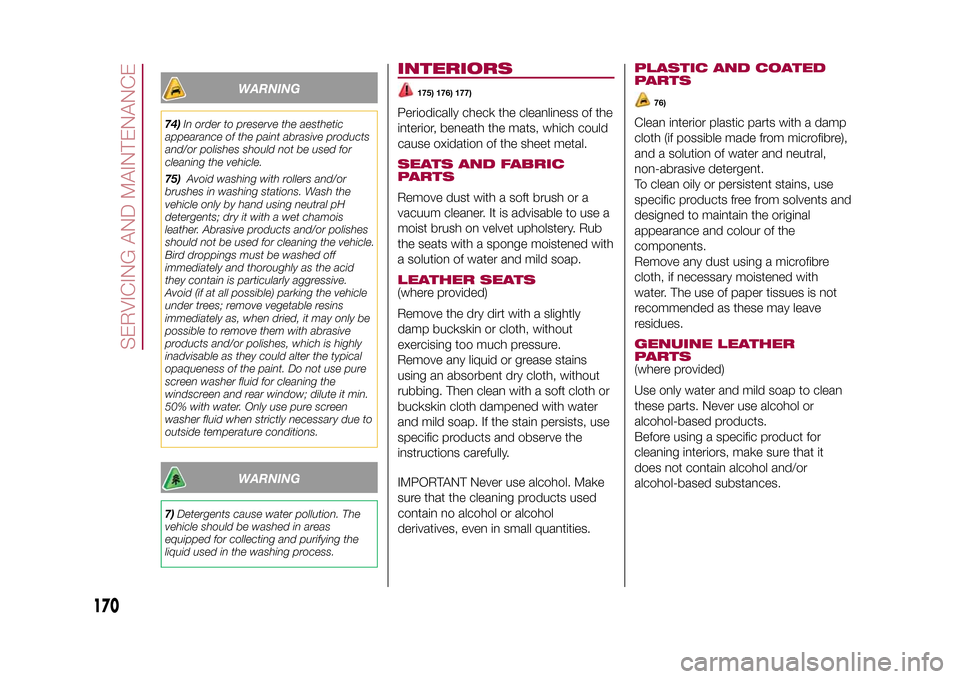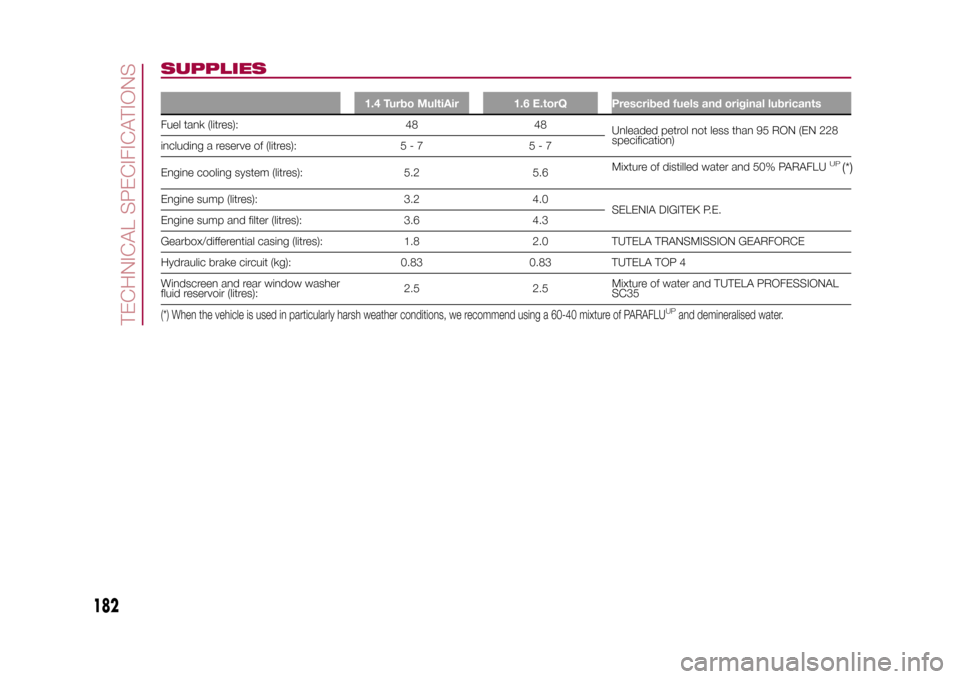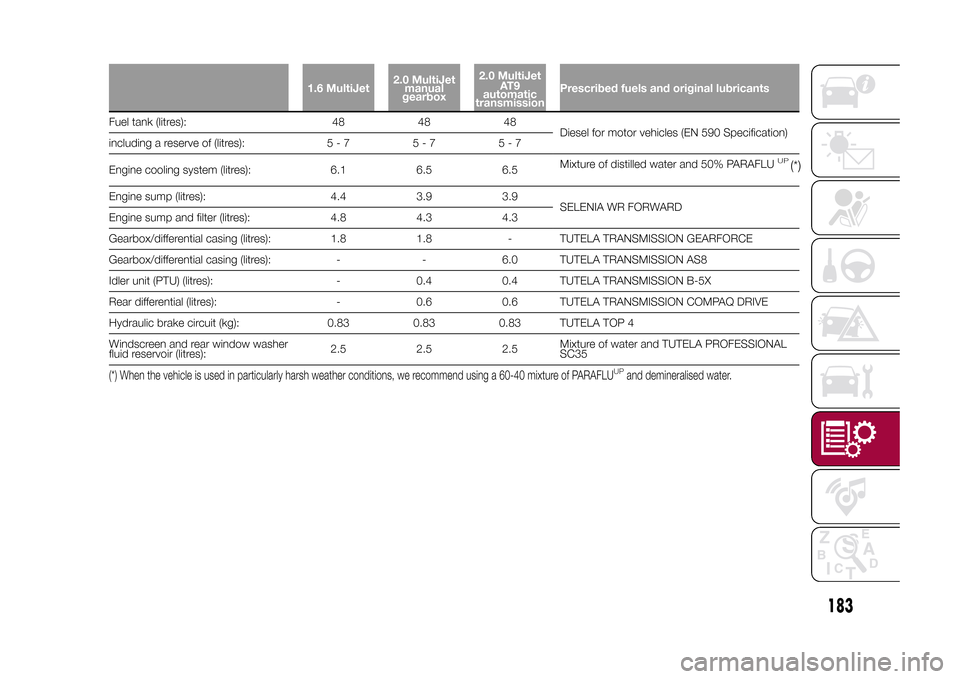2015 FIAT 500X window
[x] Cancel search: windowPage 162 of 240

ENGINE OIL
158)59)
Check the oil level a few minutes (about
5) after the engine has stopped, with
the vehicle parked on level ground.
Check that the oil level is between the
MIN and MAX references on the
dipstick A.
If the oil level is near or under the MIN
reference, add oil through the filler B
until it reaches the MAX reference.
Take out the engine oil dipstick A, clean
it with a lint-free cloth and reinsert it.
Extract it again and check that the level
is between the MIN and MAX marks
on the dipstick.Engine oil consumption
60)4)
The maximum engine oil consumption
is usually 400 grams every 1,000 km.
When the vehicle is new, the engine
needs to be run in; therefore the engine
oil consumption can only be considered
stabilised after the first 5,000 - 6,000
km.IMPORTANT After adding or changing
the oil, let the engine turn over for a few
seconds and wait a few minutes after
turning it off before you check the level.
ENGINE COOLANT
159)61)
If the level is too low, unscrew the cap
of reservoir C and add the fluid
described in the "Technical
Specifications" chapter.WINDSCREEN/REAR
WINDOW WASHER FLUID
160) 161)
If the level is too low, lift reservoir cap D
and add the fluid described in the
chapter "Technical Specifications".
IMPORTANT The headlight washer
system (present) will not operate when
the fluid level is low, even though the
windscreen/rear window washer
continues to operate.BRAKE FLUID
162) 163)62)
Check that the fluid is at the max. level.If the fluid level in the reservoir is too
low, undo reservoir cap E and add the
fluid described in the chapter "Technical
Specifications".
IMPORTANT Carefully clean the cap of
the reservoir and the surrounding
surface. Take great care to ensure that
impurities do not enter the reservoir
when the cap is opened.
For topping-up, always use a funnel
with integrated filter with mesh equal to
or lower than 0.12 mm.
IMPORTANT Brake fluid is hygroscopic
(i.e. it absorbs moisture). For this
reason, if the vehicle is mainly used in
areas with a high degree of
atmospheric humidity, the fluid should
be replaced at more frequent intervals
than specified in the "Scheduled
Servicing Plan".
AUTOMATIC
TRANSMISSION
ACTIVATION SYSTEM OIL
5)
The transmission control oil level should
only be checked at a Fiat Dealership.
160
SERVICING AND MAINTENANCE
15-12-2014 8:23 Pagina 160
Page 166 of 240

❒turn on the battery charger. At the
end of the charging process, switch the
battery charger off;
❒after having disconnected the
charging device, reconnect connector
A to the sensor C as shown.
SERVICING
PROCEDURES
65) 66) 67)
The following pages contain the rules
on therequiredmaintenance
envisaged by the technical personnel
who designed the vehicle.
In addition to these specific
maintenance instructions specified for
routine scheduled servicing, there
are other components which
may require intervention or
replacements over the vehicle’s life
cycle.ENGINE OIL
68)
Engine oil level checkTo ensure correct engine lubrication,
the oil must always be kept at the
prescribed level (see "Engine
compartment" in this chapter).AIR CLEANER
167)
Replacing the air cleanerSee the "Scheduled servicing plan" for
the correct servicing intervals.
It is advisable to replace it with a
genuine spare part, designed especially
for this vehicle.
AIR CONDITIONING
SYSTEM MAINTENANCE
69) 70)
To ensure the best possible
performance, the air conditioning
system must be checked and undergo
maintenance at a Fiat Dealership at
the beginning of the summer.WINDOWSWhen cleaning the heated windscreen
and rear window be careful, if the
defrosting function is active, regarding
the temperature of the glass; also make
sure that children do not come into
contact with the heated surface. The
glass may be hot.
Never use an abrasive detergent to
clean the surface of the windows.
Do not use scrapers or sharp items that
might scratch the windows.
Spray the detergent on the cloth to be
used for cleaning the rear view mirror.
Do not spray the detergent directly
on the glass.
Cleaning the window with hot water
could cause the removal of any labels.
164
SERVICING AND MAINTENANCE
15-12-2014 8:23 Pagina 164
Page 167 of 240

WINDSCREEN/REAR
WINDOW WIPERReplacing the windscreen wiper
bladesProceed as follows:
❒raise the wiper arm, press button A
fig. 143 of the attachment spring and
remove the blade from the arm;
❒fit the new blade, inserting the tab in
the dedicated housing in the arm and
checking that it is locked;
❒lower the wiper arm on the
windscreen.
IMPORTANT Do not operate the
windscreen wiper with the blades lifted
from the windscreen.
Replacing the rear window wiper
bladeProceed as follows:
❒widen the two tabs as shown by the
arrows and rotate cover A fig. 144
outwards;
❒undo nut B and remove arm C from
the central pin;
❒correctly align the new arm;
❒fully tighten nut B and then refit cover
A.
IMPORTANT Do not operate the rear
window wiper with the blade lifted from
the rear window.Windscreen washerThe window washer nozzles are fixed. If
there is no jet of fluid, firstly check that
there is fluid in the reservoir (see
paragraph “Engine compartment” in
this chapter). Only use the prescribed
fluid; do not use only water.Then check that the nozzle holes are
not clogged; use a needle to unblock
them if necessary.
IMPORTANT In versions with sun roof,
make sure that the roof is closed before
operating the windscreen washer
nozzles.
Rear window washerThe rear window washer nozzle is fixed.
The jet nozzle is located at the side of
the third brake light.EXHAUST SYSTEM
168) 169)71)
Adequate maintenance of the engine
exhaust system represents the best
protection against leaks of carbon
monoxide into the passenger
compartment.AUTOMATIC
TRANSMISSION
72)
Use only a gearbox fluid with the same
characteristics as those indicated in
the "Fluids and lubricants" table (see
"Technical specifications" chapter).
143
F1B0302C
144
F1B0303C
165
15-12-2014 8:23 Pagina 165
Page 171 of 240

❒if high pressure jets or cleaners are
used to wash the vehicle, keep a
distance of at least 40 cm from the
bodywork to avoid damage or
alteration. Build up of water could
cause damage to the vehicle in the long
term;
❒wash the bodywork using a low
pressure jet of water if possible;
❒wipe a sponge with a slightly soapy
solution over the bodywork, frequently
rinsing the sponge;
❒rinse well with water and dry with a
jet of air or a chamois leather.
Dry the less visible parts (e.g. door
frames, bonnet, headlight frames, etc.)
with special care, as water may
stagnate more easily in these areas. Do
not wash the vehicle after it has been
left in the sun or with the bonnet hot:
this may alter the shine of the
paintwork.
Exterior plastic parts must be cleaned
in the same way as the rest of the
vehicle.IMPORTANTAvoid parking under trees; the resin
dropped by trees makes the paintwork
go opaque and increases the possibility
of corrosion.Bird droppings must be washed off
immediately and thoroughly as the acid
they contain is particularly aggressive.
WindowsUse specific detergents and clean
cloths to prevent scratching or altering
the transparency.
IMPORTANT Wipe the rear window
inside gently with a cloth following the
direction of the filaments to avoid
damaging the heating device.HeadlightsUse a soft cloth soaked in water and
detergent for washing cars.
IMPORTANT Never use aromatic
substances (e.g. petrol) or ketones (e.g.
acetone) for cleaning the plastic lenses
of the headlights.
IMPORTANT When cleaning with a
pressure washer, keep the water jet at
least 20 cm away from the headlights.
Engine compartmentAt the end of every winter, wash the
engine compartment thoroughly, taking
care not to aim the jet of water directly
at the electronic control units or at
the windscreen/rear window wiper
motors. Have this operation performed
at a specialised workshop.
IMPORTANT The washing should take
place with the engine cold and the
ignition device in the STOP position.
After the washing operation, make sure
that the various protections (e.g. rubber
caps and guards) have not been
removed or damaged.
169
15-12-2014 8:23 Pagina 169
Page 172 of 240

WARNING
74)In order to preserve the aesthetic
appearance of the paint abrasive products
and/or polishes should not be used for
cleaning the vehicle.
75)Avoid washing with rollers and/or
brushes in washing stations. Wash the
vehicle only by hand using neutral pH
detergents; dry it with a wet chamois
leather. Abrasive products and/or polishes
should not be used for cleaning the vehicle.
Bird droppings must be washed off
immediately and thoroughly as the acid
they contain is particularly aggressive.
Avoid (if at all possible) parking the vehicle
under trees; remove vegetable resins
immediately as, when dried, it may only be
possible to remove them with abrasive
products and/or polishes, which is highly
inadvisable as they could alter the typical
opaqueness of the paint. Do not use pure
screen washer fluid for cleaning the
windscreen and rear window; dilute it min.
50% with water. Only use pure screen
washer fluid when strictly necessary due to
outside temperature conditions.
WARNING
7)Detergents cause water pollution. The
vehicle should be washed in areas
equipped for collecting and purifying the
liquid used in the washing process.
INTERIORS
175) 176) 177)
Periodically check the cleanliness of the
interior, beneath the mats, which could
cause oxidation of the sheet metal.SEATS AND FABRIC
PARTSRemove dust with a soft brush or a
vacuum cleaner. It is advisable to use a
moist brush on velvet upholstery. Rub
the seats with a sponge moistened with
a solution of water and mild soap.LEATHER SEATS(where provided)
Remove the dry dirt with a slightly
damp buckskin or cloth, without
exercising too much pressure.
Remove any liquid or grease stains
using an absorbent dry cloth, without
rubbing. Then clean with a soft cloth or
buckskin cloth dampened with water
and mild soap. If the stain persists, use
specific products and observe the
instructions carefully.
IMPORTANT Never use alcohol. Make
sure that the cleaning products used
contain no alcohol or alcohol
derivatives, even in small quantities.
PLASTIC AND COATED
PARTS
76)
Clean interior plastic parts with a damp
cloth (if possible made from microfibre),
and a solution of water and neutral,
non-abrasive detergent.
To clean oily or persistent stains, use
specific products free from solvents and
designed to maintain the original
appearance and colour of the
components.
Remove any dust using a microfibre
cloth, if necessary moistened with
water. The use of paper tissues is not
recommended as these may leave
residues.GENUINE LEATHER
PARTS(where provided)
Use only water and mild soap to clean
these parts. Never use alcohol or
alcohol-based products.
Before using a specific product for
cleaning interiors, make sure that it
does not contain alcohol and/or
alcohol-based substances.
170
SERVICING AND MAINTENANCE
15-12-2014 8:23 Pagina 170
Page 184 of 240

SUPPLIES
1.4 Turbo MultiAir 1.6 E.torQ Prescribed fuels and original lubricants
Fuel tank (litres): 48 48
Unleaded petrol not less than 95 RON (EN 228
specification)
including a reserve of (litres): 5 - 7 5 - 7
Engine cooling system (litres): 5.2 5.6Mixture of distilled water and 50% PARAFLU
UP
(*)
Engine sump (litres): 3.2 4.0
SELENIA DIGITEK P.E.
Engine sump and filter (litres): 3.6 4.3
Gearbox/differential casing (litres): 1.8 2.0 TUTELA TRANSMISSION GEARFORCE
Hydraulic brake circuit (kg): 0.83 0.83 TUTELA TOP 4
Windscreen and rear window washer
fluid reservoir (litres):2.5 2.5Mixture of water and TUTELA PROFESSIONAL
SC35(*) When the vehicle is used in particularly harsh weather conditions, we recommend using a 60-40 mixture of PARAFLU
UP
and demineralised water.
182
TECHNICAL SPECIFICATIONS
15-12-2014 8:23 Pagina 182
Page 185 of 240

1.6 MultiJet2.0 MultiJet
manual
gearbox2.0 MultiJet
AT 9
automatic
transmissionPrescribed fuels and original lubricants
Fuel tank (litres): 48 48 48
Diesel for motor vehicles (EN 590 Specification)
including a reserve of (litres): 5 - 7 5 - 7 5 - 7
Engine cooling system (litres): 6.1 6.5 6.5Mixture of distilled water and 50% PARAFLU
UP
(*)
Engine sump (litres): 4.4 3.9 3.9
SELENIA WR FORWARD
Engine sump and filter (litres): 4.8 4.3 4.3
Gearbox/differential casing (litres): 1.8 1.8 - TUTELA TRANSMISSION GEARFORCE
Gearbox/differential casing (litres): - - 6.0 TUTELA TRANSMISSION AS8
Idler unit (PTU) (litres): - 0.4 0.4 TUTELA TRANSMISSION B-5X
Rear differential (litres): - 0.6 0.6 TUTELA TRANSMISSION COMPAQ DRIVE
Hydraulic brake circuit (kg): 0.83 0.83 0.83 TUTELA TOP 4
Windscreen and rear window washer
fluid reservoir (litres):2.5 2.5 2.5Mixture of water and TUTELA PROFESSIONAL
SC35(*) When the vehicle is used in particularly harsh weather conditions, we recommend using a 60-40 mixture of PARAFLU
UP
and demineralised water.
183
15-12-2014 8:23 Pagina 183
Page 187 of 240

UseFluid and lubricant features for a correct use of
the vehicleOriginal fluids and lubricants ApplicationsLubricants and
greases for drive
transmissionGrease for constant velocity joints with low friction
coefficient. NL.G.I. 0-1 consistency FIAT 9.55580
classificationTUTELA STAR 700
Contractual Technical
Reference No. F701.C07Differential-side constant
velocity joints
SAE 75W-90 API GL5 grade synthetic lubricant. FIAT
9.55550-DA6 classificationTUTELA TRANSMISSION
B-5X
Contractual Technical
Reference No. F006.814Idler unit (PTU - 4x4
versions)
SAE 75W-90 API GL5 grade synthetic lubricant. FIAT
9.55550-DA7 classificationTUTELA TRANSMISSION
COMPAQ DRIVE
Contractual Technical
Reference No. F007.814Rear differential (4×4
versions)
Brake fluidSynthetic fluid for brake and clutch systems. Exceeds
specifications: FMVSS no. 116 DOT 4, ISO 4925 SAE
J1704 FIAT 9.55597 classificationTUTELA TOP 4
Contractual Technical
Reference No. F001.A93Hydraulic brakes and
hydraulic clutch controls
Protective agent for
radiatorsRed protective agent with antifreeze action, based on
inhibited monoethylene glycol with organic formula.
Exceeds CUNA NC 956-16, ASTM D 3306
specifications. FIAT 9.55523 classificationPARAFLU
UP
(*)
Contractual Technical
Reference No. F101.M01Cooling circuit usage
percentage: 50% water
50% PARAFLU
UP
(**)
Diesel fuel additiveAdditive for diesel with antifreeze and protective action
for diesel enginesTUTELA DIESEL ART
Contractual Technical
Reference No. F601.L06To be mixed with diesel
(25 cc per 10 litres)
Windscreen/rear
window washer fluidMixture of spirits and surfactants. Exceeds CUNA NC
956-11 specifications. FIAT 9.55522 classificationTUTELA PROFESSIONAL SC
35
Contractual Technical
Reference No.F201.D02To be used diluted or
undiluted in screen
washer/wiper systems(*) IMPORTANT Do not top up or mix with other fluids which have different specifications from those described.
(**) When the vehicle is used in particularly harsh weather conditions, we recommend using a mixture of 60%PARAFLU
UP
and 40% demineralised water.
WARNING
77)The use of products with specifications different than those indicated above could cause damage to the engine that is not covered by the
warranty.
185
15-12-2014 8:23 Pagina 185